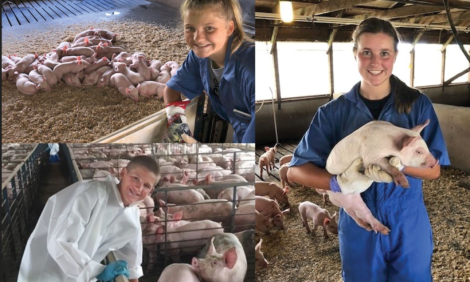



The SIV Challenge
From Pfizer Animal Health. The evolving nature of the swine influenza virus (SIV) makes it hard to control, especially in show pigs.When it comes to protecting your show pigs from the threat of disease, no vaccine can protect against everything. That is especially true with swine influenza virus (SIV), according to Max Rodibaugh, DVM, Swine Health Services, LLC, Frankfort, Indiana, USA.
"This virus is constantly changing and adapting to new conditions, which makes it more difficult to control," he explains. "But because it plays a role in causing respiratory problems and is a significant contributor to the porcine respiratory disease complex (PRDC), it poses a serious threat for swine herds." Show animals can face an even bigger threat from SIV due to the increased exposures they face at various shows throughout the season.
Over the years, SIV has evolved from one basic subtype - H1N1 - that used to occur mainly in fall [autumn] and early winter. In 1998, a new subtype - H3N2 - appeared. Researchers said it developed from human, swine and avian influenza viruses that had somehow combined. This subtype caused a swine flu epidemic because pigs were only immune to the H1N1 subtype. Some years after that, another subtype of SIV emerged - H1N2 - and it affected some pigs but was not as widespread.
Vaccines for SIV have been updated to protect against new subtypes of the virus but because new changes are always possible with this type of virus, no vaccine can guarantee to help protect animals against all strains of SIV. But research has found that protecting against two common subtypes is an effective animal health management tool. For example, FluSure® is an injectable vaccine that aids in preventing respiratory disease caused by SIV subtypes H1N1 and H3N2, which are the most often diagnosed subtypes in US herds.
Accurate Diagnosis Is Critical
These new subtypes of SIV have made diagnosis more complicated as well. But effective protection depends on knowing exactly which subtype you are dealing with.
The first step is to determine if SIV is present and a factor contributing to PRDC. Typical clinical signs include:
- Elevated temperature
- Dry, hacking cough
- Clear nasal discharge
- Labored breathing
- Animals go off feed.
If these signs are evident, your veterinarian may want to confirm the presence of SIV. This may be done through the use of tissue or nasal swab diagnostics within 24 to 48 hours after the onset of clinical signs. Blood tests to detect exposure to the virus are not accurate until 10-14 days after infection. The incubation period for SIV ranges from 1 to 3 days, and an infected animal can start to shed the virus as early as 24 hours after being infected. The severity of infection depends on several factors, including the age of the animal and its overall immune status.
The virus usually grows in the nasal passages, tonsils and lungs, and the infection is limited to the respiratory tract. Infection in the lungs can lead to secondary bacterial infection there as well.
While the death rate is usually low, SIV often causes loss of body condition and weight. Recovery begins about the sixth day post-infection, and the herd generally recovers in a week or two. If clinical cases of swine influenza become complicated with other pathogens such as Actinobacillus pleuropneumonia, Pasteurella multocida, Mycoplasma hyopneumoniae or Streptococcus suis, this can increase mortality or prolong recovery time.
Vaccinating as Part of Prevention
Since there are no specific treatments for swine influenza infections, prevention and control are very important. Treating clinically ill animals can include the use of:
- Anti-inflammatories to offer relief for severely affected animals
- Antimicrobials to prevent secondary bacterial infections
- Good management, fresh water and food, and a clean, dry environment can help a pig to develop an effective immune response, but it alone cannot stave off the disease once it is present in the herd.
It is recommended to vaccinate all pigs on the premises in order to enhance herd immunity. With FluSure all healthy hogs at least three weeks of age should receive two doses given approximately three weeks apart. In young pigs, you should wait to vaccinate until SIV antibodies that have been passed on from the mother through nursing have declined (this will depend on the vaccination status of the mother and may last until 8-12 weeks of age). After the initial two doses, semi-annual revaccination with a single dose is recommended. Do not vaccinate hogs within 21 days before slaughter.
While viruses can change - sometimes faster than we can keep up with - it is important to protect your hogs, especially show animals, from the most common viral threats. In the case of SIV, we must use the tools that we have, which include vaccines that help protect against the most common subtypes of the virus. They will help keep your show animals healthy and productive throughout the show season.
For any additional questions about SIV and an appropriate vaccination program for your show pigs, please contact your veterinarian.
Further Reading
| - | You can view more information about FluSure from Pfizer Animal Health by clicking here. |
Further Reading
| - | Find out more information on Swine Influenza by clicking here. |
September 2008









